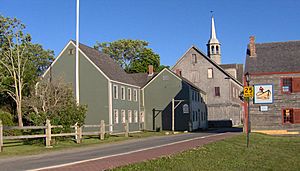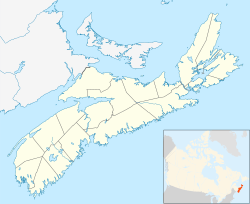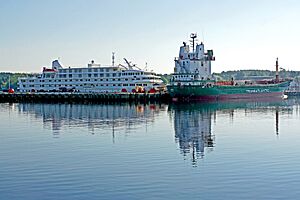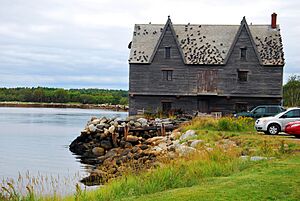Shelburne, Nova Scotia facts for kids
Quick facts for kids
Shelburne
|
||
|---|---|---|
|
Town
|
||

The Shelburne County Museum
|
||
|
||
| Motto(s):
Where Canada's history comes alive
|
||
| Country | Canada | |
| Province | Nova Scotia | |
| County | Shelburne | |
| Founded | 1783 | |
| Incorporated | April 4, 1907 | |
| Government | ||
| • Type | Town of Shelburne Council | |
| Area
(2016)
|
||
| • Land | 8.84 km2 (3.41 sq mi) | |
| Highest elevation | 6 m (20 ft) | |
| Lowest elevation | 0 m (0 ft) | |
| Population
(2021)
|
||
| • Total | 1,644 | |
| • Density | 187.9/km2 (487/sq mi) | |
| • Change (2016-21) | ||
| • Dwellings | 917 | |
| Time zone | UTC-4 (AST) | |
| • Summer (DST) | UTC-3 (ADT) | |
| Postal code(s) |
B0T 1W0
|
|
| Area code(s) | 902 & 782 | |
| Access Routes | ||
Shelburne is a town in southwestern Nova Scotia, Canada. It has a large, safe harbour. The town is known for its rich history and beautiful waterfront.
Contents
Discover Shelburne's Past
Shelburne's story began about 13,000 years ago. The Mi'kmaq were the first to live here. They called the harbour Logumkeegan or Sogumkeagum. They travelled by canoe and set up camps along the Roseway River.
Early European Arrivals
European explorers and fishermen came to Shelburne in the 1500s. They followed the Mi'kmaq routes for fishing and hunting. French settlers arrived in Nova Scotia between 1632 and 1653. Some started a fishing village called Port Razoir in Shelburne.
Ownership of these lands often changed between France and England. After the War of Spanish Succession in 1713, Nova Scotia became British.
The Acadian Expulsion
In 1755, the British began to force the Acadians to leave. This was because the Acadians refused to fight against the French. Many Acadian families were separated and moved to other places. Some found safety with the Mi'kmaq people. By 1764, some Acadians were allowed to return to the Maritimes.
Loyalists and Black Loyalists Arrive
In 1783, a big change happened. After the American Revolution, many people loyal to Britain moved to Nova Scotia. These were called Loyalists. About 5,000 arrived in Shelburne Harbour.
Among them were about 1,500 Black Loyalists. These were formerly enslaved African Americans. They had fought with the British for their freedom. They settled in Birchtown, near Shelburne. It became the largest community of free Black people in North America.
However, Black Loyalists faced many challenges. They waited longer for land grants. Their land was often smaller and in worse locations. Many were forced into difficult jobs. Some were even kidnapped and sold back into slavery.
Growth and Challenges
By 1784, the population of Shelburne reached 10,000. It was larger than Halifax or Montreal at the time. Industries like fishing and lumber began to grow.
But tensions also grew. On July 26, 1784, a group of white Loyalists attacked a Black preacher's home. This event is known as North America's first race riot. It showed the unfair treatment Black Loyalists faced.
Shelburne's economy soon declined. Many Black Loyalists moved away. In 1791, many from Birchtown left for a new colony in Sierra Leone. By the 1820s, Shelburne's population dropped to about 300.
In 1818, Welsh immigrants arrived. They started the first Welsh settlement in Canada, called Welshtown.
Shelburne became an official town in 1907. Its historic waterfront is still important today. Many buildings from the 1700s and 1800s still stand. These include the Shelburne County Museum and Christ Church.
Shipbuilding History
Building ships has always been a big part of Shelburne's history. The first ship, the Roseway, was launched here in 1786. Areas like Commissary Island and Black's Brook became busy shipyards.
Famous shipbuilders like Donald McKay started their careers here. McKay later became known for building fast clipper ships in the United States. Shelburne shipyards built many fishing schooners. They also built the famous research yacht, the schooner Blue Dolphin, in 1926.
In May 1945, a German submarine, U-889, surrendered to the Canadian Navy in Shelburne.
Historic Buildings
Many of Shelburne's buildings are very old. They date back to the time of the Loyalists.
- The Shelburne County Museum is a restored home from 1787.
- Christ Church (Anglican) was first built in 1790. The original church burned down in 1971, but a new one was built on the same spot.
- Tottie's Store is believed to be from around 1800.
- At the corner of Water Street and George Street, you can see homes built in 1783.
After 1787, many settlers left Shelburne. They moved to other places like England or the United States. This was because the town was not yet able to support everyone.
Shelburne Today
Shelburne officially became a town on April 4, 1907. Some families living here today are descendants of those first Loyalists.
Fishing is still the main industry. Millions of pounds of fish pass through the port each year. Other important activities include tourism and fish processing. Factories here make barrels, granite monuments, and marine supplies.
The Shelburne shipyard still does some work for large shipbuilding contracts. Cooke Aquaculture also has a salmon farming operation here.
The town has local news from The Tri-County Vanguard and radio stations.
Environmental Concerns
In 1946, a landfill was built near the African Nova Scotian community in Shelburne. This raised concerns about environmental racism. This means that minority communities often face more environmental hazards.
The landfill took in different types of waste. Burning waste caused air pollution. This made it hard for people to breathe and affected their health. Water resources were also polluted by waste runoff. People worried about higher rates of cancer and other illnesses.
Groups like the ENRICH Project and the South End Environmental Injustice Society (SEED) worked to address these issues. They showed that waste dumps are often near African Nova Scotian and Mi'kmaq communities. Their efforts led to the landfill's closure in December 2016. This work has helped fight environmental racism across Canada.
Shelburne on Screen
Shelburne's historic waterfront has been a popular spot for movies and TV shows.
- In 1992, Mary Silliman's War was filmed here.
- In 1994, The Scarlet Letter used Dock Street as a set. Some buildings still have the grey paint from that movie.
- Other movies like Virginia's Run and Wilby Wonderful were also filmed in Shelburne.
- In 2009, parts of the TV miniseries Moby Dick were filmed here. Actors like William Hurt and Donald Sutherland were in it.
- In 2014, The Book of Negroes was filmed on Dock Street.
- Parts of the 2019 documentary There's Something in the Water were also filmed in Shelburne.
Community Resources
McKay Memorial Library
The McKay Memorial Library is located at 17 Glasgow Street. It is part of the Western Counties Regional Library. The library opened in Shelburne on February 15, 1970. It moved to its current spot in 1989.
Parks and Recreation
- The Islands Provincial Park is located nearby. It offers a great place to enjoy nature.
Climate in Shelburne
Shelburne has a warm-summer humid continental climate. This means it has warm summers and cold, wet winters. The Atlantic Ocean helps keep temperatures from getting too extreme.
Winters have snow, freezing rain, and regular rain. Snow usually doesn't stay on the ground for long. Spring is cool and often damp. Summers have morning fogs in June and July, followed by clear, warm days. Autumn has pleasant days and cool nights.
Shelburne can experience strong coastal storms called Nor'easters. These bring heavy rains and strong winds. Hurricanes can also affect the area from August to October.
| Climate data for Shelburne, NS | |||||||||||||
|---|---|---|---|---|---|---|---|---|---|---|---|---|---|
| Month | Jan | Feb | Mar | Apr | May | Jun | Jul | Aug | Sep | Oct | Nov | Dec | Year |
| Record high °C (°F) | 13.9 (57.0) |
14 (57) |
18.3 (64.9) |
25.6 (78.1) |
31.1 (88.0) |
34.5 (94.1) |
33.3 (91.9) |
36.1 (97.0) |
27.8 (82.0) |
24.5 (76.1) |
20.6 (69.1) |
15 (59) |
36.1 (97.0) |
| Mean daily maximum °C (°F) | 0.9 (33.6) |
1 (34) |
5 (41) |
10 (50) |
15.4 (59.7) |
19.9 (67.8) |
23.1 (73.6) |
23.1 (73.6) |
19.3 (66.7) |
14.1 (57.4) |
9 (48) |
4.1 (39.4) |
12.1 (53.8) |
| Daily mean °C (°F) | −3.7 (25.3) |
−3.5 (25.7) |
0.5 (32.9) |
5.2 (41.4) |
9.9 (49.8) |
14.3 (57.7) |
17.6 (63.7) |
17.6 (63.7) |
13.9 (57.0) |
9 (48) |
4.6 (40.3) |
−0.5 (31.1) |
7.1 (44.8) |
| Mean daily minimum °C (°F) | −8.3 (17.1) |
−8 (18) |
−4 (25) |
0.3 (32.5) |
4.4 (39.9) |
8.7 (47.7) |
12.1 (53.8) |
12.1 (53.8) |
8.4 (47.1) |
3.9 (39.0) |
0.2 (32.4) |
−5 (23) |
2.1 (35.8) |
| Record low °C (°F) | −22.8 (−9.0) |
−23.4 (−10.1) |
−24 (−11) |
−9.4 (15.1) |
−4.4 (24.1) |
0.5 (32.9) |
3.3 (37.9) |
2.4 (36.3) |
−3.5 (25.7) |
−7.8 (18.0) |
−14.3 (6.3) |
−24.6 (−12.3) |
−24.6 (−12.3) |
| Average precipitation mm (inches) | 151.3 (5.96) |
107.3 (4.22) |
121.5 (4.78) |
123 (4.8) |
96.3 (3.79) |
102.7 (4.04) |
105.6 (4.16) |
82.3 (3.24) |
101.9 (4.01) |
112.5 (4.43) |
132.1 (5.20) |
156.6 (6.17) |
1,393.1 (54.85) |
| Average rainfall mm (inches) | 104.5 (4.11) |
75.5 (2.97) |
93 (3.7) |
115.1 (4.53) |
96.2 (3.79) |
102.7 (4.04) |
105.6 (4.16) |
82.3 (3.24) |
101.9 (4.01) |
110.4 (4.35) |
126.4 (4.98) |
123.3 (4.85) |
1,236.9 (48.70) |
| Average snowfall cm (inches) | 49.6 (19.5) |
31.3 (12.3) |
26.5 (10.4) |
7.4 (2.9) |
0.1 (0.0) |
0 (0) |
0 (0) |
0 (0) |
0 (0) |
2 (0.8) |
5.6 (2.2) |
31.7 (12.5) |
154.2 (60.7) |
| Source: climate.weatheroffice.ec.gc.ca | |||||||||||||
People of Shelburne
In 2021, Shelburne had a population of 1,644 people. They lived in 794 homes. The town covers an area of 8.75 square kilometers.
Notable People
- Jody Holden: A beach volleyball player.
- Gideon White: A politician and captain in the Duke of Cumberland's Regiment.
Images for kids






